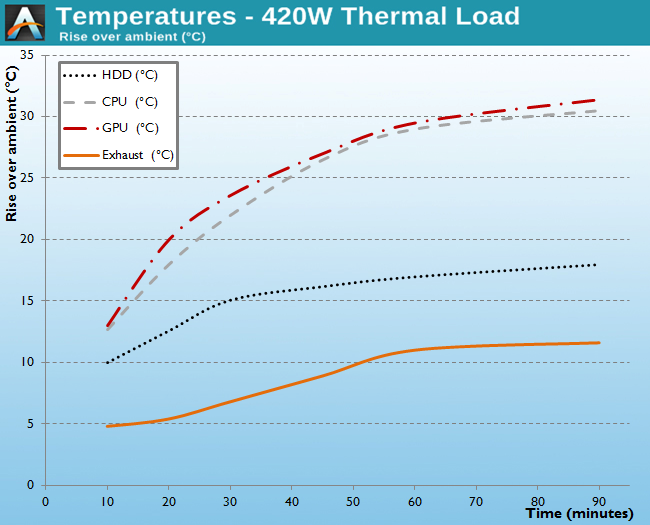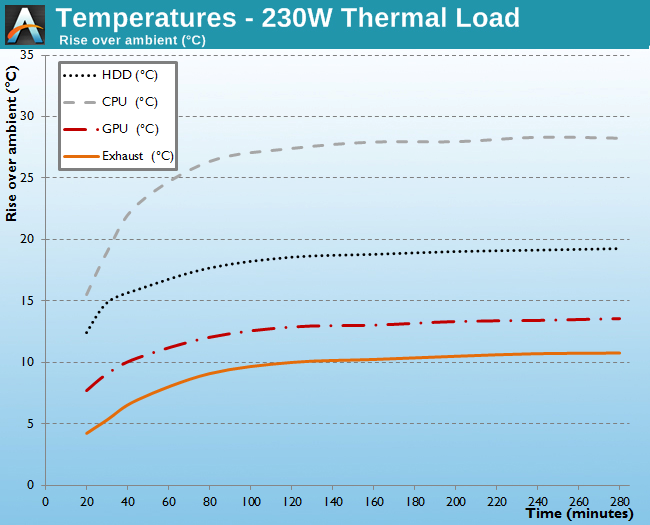Corsair Carbide Air 240 Case Review
by E. Fylladitakis on August 15, 2014 6:00 AM EST- Posted in
- Cases/Cooling/PSUs
- Corsair
- ATX
- Case
- Carbide
Test Setup
Professional testing requires the emulation of real-world situations but with repeatable results; thus, a perfectly controllable test setup and environment are required, especially for comparable results. Testing the thermal performance of any case with a typical real-world setup technically limits the comparability of the results to this setup alone, as an active system interacts with its environment and the change of a single component would alter myriads of variables. For our case reviews, we developed synthetic loads that emulate the thermal output of real systems, but these are passive, steady and quantifiable loads. This allows us to test the thermal capabilities of the case alone, as if it would have to deal with the entire thermal load by itself, regardless of what system an end user might install in it.
Laboratory data loggers are used to monitor the PT100 sensors and control the safety relays, which are fully accessible via our custom software. We have created three such loads, and we'll use the Micro-ATX load for this case. The Micro-ATX version simulates a 180W CPU, 40W VRM, 20W RAM, and 1 × 120W GPU card thermal load. Finally, two 3.5" HDD dummy loads have also been installed, with each of them converting 30W of electrical power to thermal. Note that the total load is generally more important than the individual elements, and the total thermal load of the Micro-ATX test setup is up to 420 Watts. As such, the thermal load is very high and only the best of cases will be able to handle it for more than a few minutes. For comparison purposes, we are also performing a test with a thermal load of 230W by reducing the CPU load to 90W, removing one disk load and using a low-profile, 50W version GFX load.
Thermal testing is performed with all of the case's stock fans operating at maximum speed. Standard noise testing has been performed with a background noise level of 30.4dB(A). Advanced noise testing is also being performed, in order to assess the ability of the case to dampen the noise of the components installed inside it. This includes the installation of two noise-generating sources (strong fans) inside the case, one positioned approximately over the first expansion slot and one over the CPU area, which generate ≈ 44.2 dB(A) when unobstructed. During the advanced noise test, all stock cooling options of the case are disabled.
Results and Discussion
As we expected from a case designed for ventilation, and despite its relatively compact size, the Carbide Air 240 displays exceptional thermal performance, significantly superior to that of the Mini-ITX Obsidian 250D. Although a direct comparison is not really possible, as the GPU load we use to test ATX cases is much higher, it would appear that the Carbide Air 240 has little to be jealous of Midi-ATX cases as well, delivering CPU and HDD temperatures that can easily rival cases such as the XFX Bravo 01 and Corsair's own Obsidian 450D.
The three stock cooling fans of the Carbide Air 240 are fairly weak, but that also has a positive effect on the acoustic performance of the case. With only the stock cooling fans installed, the Carbide Air 240 is a relatively quiet system, which can be made entirely quiet by simply connecting the fans onto the motherboard headers and leaving their speed control up to the BIOS. However, due to its design, the Carbide Air 240 cannot dampen the noise of the components installed inside it. Our testing revealed nearly zero noise-dampening capabilities, which is true of any case with so many openings on all sides.













63 Comments
View All Comments
blackmagnum - Friday, August 15, 2014 - link
Cool case. I hope the Lan gaming boys receive it with open arms, but without a handle it won't be moving anywhere.The_Assimilator - Friday, August 15, 2014 - link
With one hand Corsair giveth, with the other they taketh away... Air 540 had no 3.5" mounts behind the motherboard but two 5.25" bays; this case has three 3.5" mounts but no 5.25" bays.What we really need is an Air 550, which would be the Air 540 with 3.5" mounts behind the motherboard tray. GET IT RIGHT CORSAIR.
3DoubleD - Friday, August 15, 2014 - link
I have the opposite opinion. Kill 5.25" with fire. Never use it and it takes up tons of space. Optical disc drives now belong outside the case - especially one this small (if you even bother to get one! - I haven't used mine in 4 years).3DoubleD - Friday, August 15, 2014 - link
I don't think I drank enough coffee before I posted, you aren't saying they should put in a 5.25" bay into this case, my bad.notlurking - Friday, August 15, 2014 - link
Many still need the 5.25". Someone needs to do the rips that you download. If this were a tiny case, I'd understand the lack of an external 5.25. But it's 15.75" deep!HisDivineOrder - Sunday, August 17, 2014 - link
Many may still need 5.25", but "most" of them only "need" it occasionally. As such, "most" are fine using a USB optical drive for that occasional need.The_Assimilator - Friday, August 15, 2014 - link
It takes up a lot of space, but some people (e.g. those with fan controllers, like me) do require it. And I also haven't used an internal optical drive in half a decade or so.Grok42 - Saturday, August 16, 2014 - link
99.9% of the cases still have a 5.25" bay. If you are still living in 1999 then by all means don't buy this case. For a lot of people, this case will be on the short list of just a few rare cases that leave behind physical media.MadMan007 - Saturday, August 16, 2014 - link
I don't understand the whole push against 5.25" bays. They are *universal bays* that can be used for any number of things, including a HDD, fan controller, optical drive, card reader, etc etc or just left empty. What's the problem with having them in a case that isn't ultra-compact to begin with?nissefar - Saturday, August 16, 2014 - link
Because most people do not have an use for it anymore and makes cases larger than necessary.